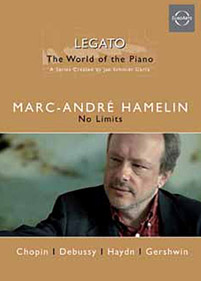Le pianiste Marc-André Hamelin mériterait d’être plus connu. EuroArts lui rend hommage dans une nouvelle collection Legato créée par Jan Schmidt-Garre. Marc-André Hamelin est né le 5 septembre 1961 au Québec. C'est grâce à son père, pianiste amateur, qu'il découvre le piano. Deux autres professeurs ont marqué son apprentissage : Harvey Weeden, professeur à la Temple University de Philadelphie, puis Russel Sherman. L'idée de devenir pianiste professionnel lui est venue peu à peu alors qu’il faisait des études de sciences. En 1982, il gagne un premier concours international à l'université d'Afrique du Sud à Pretoria et en 1985, il obtient le premier prix du Carnegie Hall International American Music Competition. Marc-André Hamelin est alors lancé. Il s'est produit depuis avec de nombreux orchestres américains et européens, chinois et australiens et aime à visiter les œuvres peu connues. Dans sa discographie, figurent les noms de nombreux compositeurs peu réputés aux côtés de grands noms : Alkan, Bernstein, Bolcom, Henselt, Korngold, Joseph Marx, Shchedrin, Catoire, Godovski, Grainger, Kapustin, Medtner,Ornstein, Reger, Roslavets, Rzewski, ou encore Liszt et Chostakovitch, Schumann, Szymanowski, Villa Lobos, Albéniz. Scriabine. Le DVD est divisé en trois parties, une partie Portrait (30 minutes), une partie Concert (90 minutes) et une partie Interview (70 minutes de bonus) hélas non sous-titrée. Cela dit, nous avons, pour une fois, le temps de faire véritablement connaissance avec un interprète, si l’on excepte qui se révèle rigoureux, délicat et curieux. Il y a d’ailleurs un passage fort intéressant à ce sujet concernant la démarche de Marc-André Hamelin, quand il fait remarquer que l’on joue trop vite une pièce du second livre des Préludes de Claude Debussy. Il s’agit du Général Lavine. C’est un cake-walk, nous explique le pianiste (et d’après Claude Debussy lui-même), et un cake-walk est un ragtime lent. Et voilà le pianiste qui joue le morceau comme on le joue habituellement, puis à sa manière ! Le prélude prend alors forme devant nous ! Bref, le récital que nous offre le pianiste est absolument magnifique. Au programme, la sonate pour piano Hob. XVI : 31 de Haydn, la sonate N°3 pour piano de Chopin, le second livre des Préludes de Claude Debussy, L’Etude N°7 (d’après Tchaikovski) de Marc-André Hamelin (notre homme est aussi compositeur) et enfin Do, do do de George Gershwin.
Yannick Rolandeau The pianist Marc-André Hamelin deserves to be better known. EuroArts pays tribute to him in a new collection Legato created by Jan Schmidt-Garre. Marc-André Hamelin was born on September 5, 1961 in Québec. He discovered the piano thanks to his father, who was an amateur pianist. Two other professors left their mark on his education: Harvey Weeden, professor at Temple University in Philadelphia, then Russel Sherman. The idea of becoming a professional pianist came to him when he was studying science. In 1982 he won his first international competition at the University of South Africa in Pretoria, and in 1985 obtained the first prize in the Carnegie Hall International American Music Competition. Marc-André Hamelin thus began his career. He has since played with numerous American, European, Chinese and Australian orchestras, and likes to visit little known works. In his discography figure the names of many composers of lesser reputation as well as those more well-known: Alkan, Bernstein, Bolcom, Henselt, Korngold, Joseph Marx, Shchedrin, Catoire, Godovski, Grainger, Kapustin, Medtner,Ornstein, Reger, Roslavets, Rzewski, but also Liszt and Chostakovitch, Schumann, Szymanowski, Villa Lobos, Albéniz, Scriabine. The DVD is divided into three parts: a portrait (30 minutes), a concert (90 minutes), and an interview (70 minutes in bonus) regrettably without subtitles. All said, for once we have the time to really get to know an interpreter, except that he reveals himself to be rigorous, delicate and curious. Furthermore, there is an extremely interesting passage concerning Marc-André Hamelin’s approach when he notes that a piece from Claude Debussy’s second book of Préludes is usually played too fast. He is talking about Général Lavine. It’s a cake-walk, explains the pianist (as does Claude Debussy too), and a cake-walk is a slow ragtime. The pianist goes on to play the piece as is habitually done, then does it his way! The prélude thus takes shape before us! In short, the recital the pianist presents us is absolutely magnificent. On the program: the Sonata for Piano Hob. XVI:31 by Haydn, the Sonata N°3 for Piano by Chopin, the Second Book from the Préludes by Claude Debussy, the Étude N°7 (after Tchaikovsky) by Marc-André Hamelin (the man is a composer too), and finally “Do, Do, Do” by George Gershwin. Translation Lawrence Schulman |  |